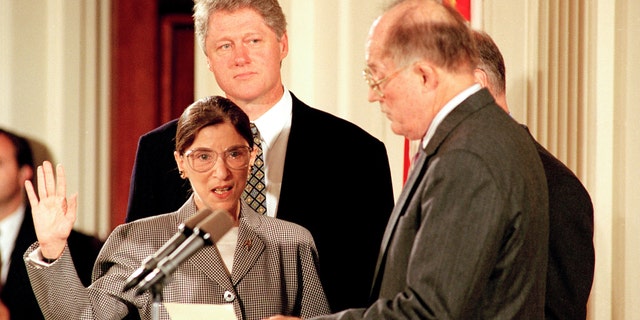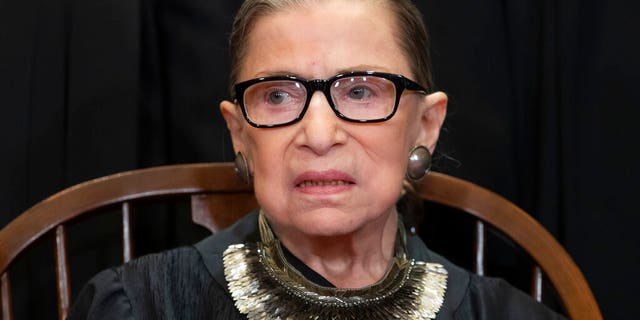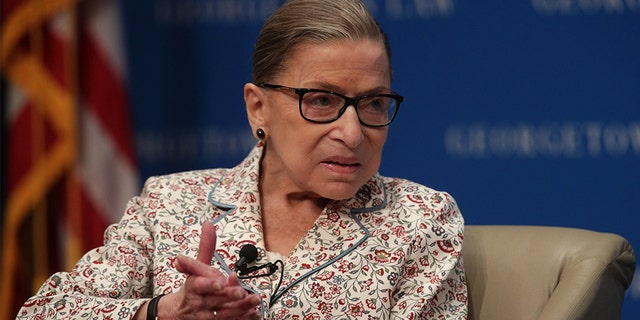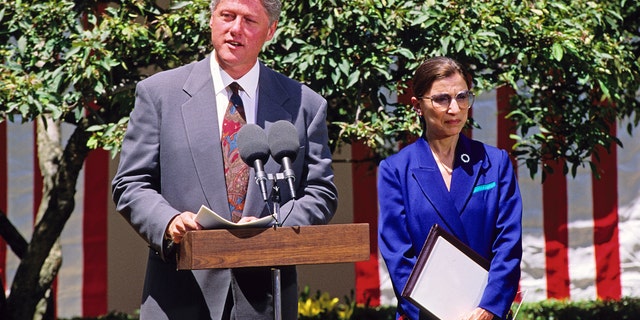Supreme Court Justice Ruth Bader Ginsburg dead at 87
'Our Nation has lost a jurist of historic stature,' Chief Justice John G. Roberts, Jr. said
U.S. Supreme Court Justice Ruth Bader Ginsburg dies at age 87.
Ruth Bader Ginsburg, the enigmatic, longtime Supreme Court
justice who attained near cult-like status among progressive circles,
died Friday at the age of 87 from complications surrounding metastatic
pancreatic cancer.
The
late Supreme Court justice, who spent more than two decades on the
bench in the highest court of the land, is survived by her two children,
Jane Carol and James Steven Ginsburg.
“Our Nation has lost a
jurist of historic stature," Chief Justice John G. Roberts, Jr. said in a
Friday evening statement. "We at the Supreme Court have lost a
cherished colleague. Today we mourn, but with confidence that future
generations will remember Ruth Bader Ginsburg as we knew her -- a
tireless and resolute champion of justice.”
Ginsburg, who was appointed to the Supreme Court in 1993 by President Bill Clinton,
was known for her soft-spoken demeanor that masked an analytical mind, a
deep concern for the rights of every American and a commitment to
upholding the Constitution.
Supreme Court Chief Justice William Rehnquist, right, administers
the oath to defend the Constitution to Ruth Bader Ginsburg as President
Bill Clinton looks on in the East Room of the White House in Washington,
D.C., Tuesday, Aug. 10, 1993. (AP Photo/Barry Thumma)
"She changed the way the Supreme Court views
the issue, and she changed millions of people's lives in the process,"
said David Schizer, who served as a law clerk during Ginsburg's first
year on the high court bench in 1993. "She did it with her soft-spoken,
quiet manner. She understood if you're trying to do something momentous,
you should present it as quite ordinary."
READ: SUPREME COURT'S STATEMENT ON RUTH BADER GINSBURG'S DEATH
She
had battled back from two forms of cancer in the past but her health
began to take a downturn in December 2018 when she underwent a pulmonary
lobectomy after two malignant nodules were discovered in the lower lobe
of her left lung.
On Jan. 7, 2019, the Court announced she would
miss oral arguments that day for the first time since she joined as she
continued to recuperate from that surgery.
From Brooklyn to the bench
Born
in 1933 in Brooklyn, young Ruth's early influence was her mother,
Celia, who instilled in her daughter the value of education and dignity.
"She taught me," Ginsburg said, "be someone who holds fast to her
convictions and her self-respect, someone who is a good teacher, but
doesn't snap back in anger. Recriminations do no good."
To her lifelong sadness, Ruth Bader's mother died of cancer the day before her high school graduation in 1948.
RUTH BADER GINSBURG UNDERGOES PROCEDURE AT NYC HOSPITAL, EXPECTED TO BE RELEASED BY END OF WEEK
"I
had the good fortune to be a Jew born in the U.S.A. My father left
Odessa bound for the New World in 1909, at age 13," Ginsburg reminisced
in 2004 at a Holocaust remembrance ceremony. "My mother was first in her
large family to be born here, in 1903... What is the difference between
a bookkeeper in New York's Garment District and a Supreme Court
justice? Just one generation, my mother's life and mine bear witness."
FILE - In this Nov. 30, 2018 file photo, Associate Justice Ruth
Bader Ginsburg sits with fellow Supreme Court justices for a group
portrait at the Supreme Court Building in Washington. The Supreme Court
announced Aug. 23, 2019, that Ginsburg has been treated for a malignant
tumor. (AP Photo/J. Scott Applewhite, File)
(AP)
As a
child, Ginsburg wanted to be an opera star, but soon found her brain
would carry her farther than her voice, which remained tinged with a
thick New York accent.
She finished first in her class as a
Cornell undergrad. Later at Harvard and Columbia Law Schools, she
juggled raising a daughter, helping her husband Martin recover from
cancer, and finishing her own studies. As one of nine women at Harvard
Law, her initial reception was chilly, with one professor telling her
and the eight other women of the Class of 1959 how it felt to take the
spots that should have gone to more "qualified" men.
She made the
law review, and finished as the top student at Columbia, where she had
transferred in her third year. Those impeccable academic credentials
evidently were not good enough for Ginsburg to get a job in a New York
law firm or a top judicial clerkship. So she went into teaching, and
found a new calling.
"Those experiences along with others really
galvanized her interest in women's rights litigation," said
Margo Schlanger, a Washington University law professor and former
Ginsburg law clerk.
RUTH BADER GINSBURG HAS BEEN UNDERGOING CHEMOTHERAPY TO TREAT RECURRENCE OF CANCER
Her
personal experiences collided with monumental social changes in the
1960s. While teaching at Rutgers, Ginsburg feared losing her non-tenured
position when she became pregnant, so she wore large clothing to hide
it. One of the first cases she helped litigate involved teachers forced
to give up their jobs when they became pregnant.
WASHINGTON, DC - JULY 02: U.S. Supreme Court Associate Justice
Ruth Bader Ginsburg participates in a discussion at Georgetown
University Law Center July 2, 2019 in Washington, DC. The Georgetown
University Law Center’s Supreme Court Institute held a discussion on
"U.S. Supreme Court Justice Ruth Bader Ginsburg: A Legacy of Gender
Equality in Life and Law." (Photo by Alex Wong/Getty Images)
(Photo by Alex Wong/Getty Images)
“I
had the great fortune to be alive and a lawyer in the late 1960s," said
Ginsburg, "when for the very first time in the history of this country
it became possible to urge before courts successfully that society would
benefit enormously if women were regarded as people equal in stature to
men."
With the help of her students, Ginsburg argued six cases
before the Supreme Court in the 1970s, winning five of them before an
all-male group that included her future benchmates William Rehnquist,
Harry Blackmun, and John Paul Stevens.
Her strategy was to take a
measured approach, carefully choosing cases that would promote equality
but not appear radical to often skeptical federal courts.
"It was
very much with the model of the NAACP's Legal Defense Fund, led by
Thurgood Marshall," Schlanger said. "She had this idea that you have to
build precedence step-by-step."
GINSBURG EVISCERATES 9TH CIRCUIT'S HANDLING OF IMMIGRATION CONSULTANT'S CASE
Ginsburg
also tried to expand the 14th Amendment's traditional ban on racial
discrimination to gender, and to show the effect stereotyping had on
limiting opportunities for women.
“Race discrimination was
immediately perceived as evil, odious, and intolerable," Ginsburg said
during her 1993 confirmation hearings for the Supreme Court. "But the
response I got when I talked about sex discrimination was, 'What are you
talking about? Women are treated ever so much better than men.' I was
talking to an audience that thought... I was somehow critical about the
way they treated their wives and their daughters."
Among the cases
she argued: Weinberger v. Wisenfeld (1975), in which a father wanted to
stay home and take care of his young son after his wife had died
suddenly in childbirth. Social Security would not pay benefits for the
man, even though had the situation been reversed, the woman would
receive money, based on the man' salary. The thinking was: husbands
earned the money, the wife took care of the house and family. The
Supreme Court ruled unanimously for the father.
American politician US President Bill Clinton speaks as he names
Judge Ruth Bader Ginsburg, of the United States Court of Appeals for the
District of Columbia, to be Associate Justice of the Supreme Court in
the Rose Garden of the White House, Washington DC, June 14, 1993. She
was confirmed, on August 3, 1993, to the position vacated by retiring
Associate Justice Byron White. (Photo by Ron Sachs/CNP/Getty Images)
But that careful approach and her belief that
"courts needed to be educated" had its critics. Some feminists believed
differences in the sexes, in many cases, should allow for preferred
treatment for women, instead of a pure gender-neutral lens.
“I
know there are people who think those cases didn't go far enough,"
said Schlanger, "and the theories of equality that say men and women
should be treated basically without much distinction by the law is not
everyone's favorite approach to equality. But that's not a view [held by
more radical gender activists] that was very likely to succeed, and her
approach did succeed."
RUTH BADER GINSBURG RELEASED FROM HOSPITAL AFTER INFECTION
That
success brought Ginsburg a national reputation and in 1980 President
Jimmy Carter nominated her to the prestigious U.S. Court of Appeals for
the District of Columbia.
Thirteen years later, President Clinton
chose her to fill the Supreme Court seat of retiring Justice Byron
White, citing not only her experience but her "big heart."
Ironically
some of the opposition to her nomination came from feminists, who did
not like her criticism over the legal reasoning of Roe v. Wade, which
permitted abortion. That ruling grounded first trimester abortions in
the right to privacy, thereby overturning state laws that varied widely
on access to the procedure. Ginsburg believed a more gradual
liberalization to abortion would have kept the issue back in the states,
avoiding the social and political upheaval that has been part of Roe's
legacy. The law on abortion was evolving at the time of Roe, Ginsburg
recalled in 2005. "The Supreme Court stopped all that by deeming every
law-- even the most liberal-- as unconstitutional. That seemed to me not
the way courts generally work."
But Ginsburg, in her rulings,
upheld reproductive choice. "When government controls that decision for
her, she's being treated as less than a full adult human being
responsible for her own choices," she said during her confirmation.
Notorious RBG
One
of Ginsburg's first clerks on the high court was David Schizer, later
dean at Columbia Law School, Ginsburg's alma mater. Despite being the
first justice named by a Democratic president in 26 years, and her
generally left-leaning views, Schizer recalls how quickly she fit in
with the legal and social culture of this exclusive "club."
RUTH BADER GINSBURG DECRIES WASHINGTON 'DYSFUNCTION' AMID IMPEACHEMENT TRIAL
"People
who don't agree with her policy instincts still think the world of her
as a judge. Justice Scalia [the late conservative] once said if he were
ever stranded on a desert island with a liberal, he'd want it to be Ruth
Ginsburg."
Clerks
and staff described her as a mother figure of sorts, keeping track of
birthdays, anniversaries, even dentist appointments. Despite deep
affection and a nurturing personality, she was also a stern taskmaster,
pushing hard for excellence in the often tedious, detailed-oriented work
of the Court: preparing arguments, writing opinions. Ginsburg, friends
said, was even harder on herself, often working all night. She has been
known to take a flashlight to a movie theater, catching up on her
caseload, while still following the plot.
In 1999, came a near
tragedy. Diagnosed with colon cancer, she underwent emergency surgery,
yet two weeks later, she was back on the bench. While keeping up her
workload, she had chemotherapy and radiation treatment. Her only public
words at the time: "I am still mending but have progressed steadily."
"Some
of us were angry with her, but we were wrong," Schizer said. "We kept
telling her to slow down, we kept telling her to take it easy, I sent
her a couple of fiction books to read, and she wouldn't have any of it.
She just bore down, went through the [cancer] treatment, treated it as
part of her work. It was a lesson to me in how to deal with adversity,
and she dealt with it with grace. And she basically refused to let
anyone help her, because the way she could help herself was by doing
things herself."
A 2009 diagnosis for pancreatic cancer led to
fears she would retire then, but again, Ginsburg was back on the job
within days, even working on her caseload from the hospital bed after
initial surgery to remove the tumor. A year later, she was on the bench
the day after her husband Martin died from cancer, telling friends
privately he would have wanted it that way.
ERA: WHAT TO KNOW ABOUT THE EQUAL RIGHTS AMENDMENT
Later
in her career, she developed an Internet cult following as the
"Notorious RBG," for her blistering dissents on divisive issues, and for
her octogenarian workout routines inside the court's gym. But
controversy followed her, too, for her pointed 2016 criticism of
then-candidate Donald Trump, calling him, among other things a "faker."
Dreams Come True
The
power of a justice comes from the strength of the opinions she writes,
whether it breaks new constitutional ground, or affirms existing
precedent. Bridging consensus helps build allies to one's views on often
hot-button issues. Ginsburg, say legal scholars, tended to rule on
procedure, rather than establishing broad principles of social reform.
That strategy not to overreach won her admiration from her more
conservative colleagues, but her generally liberal record remained
intact.
Yet she never backed down from her often tough-sounding
rhetoric. On the death penalty, she wrote a 2004 majority opinion
slamming Texas prosecutors for their behavior in a capital trial, which
the Court found was riddled with errors, and worse. "When police or
prosecutors conceal significant exculpatory or impeaching material, we
hold it is ordinarily incumbent on the state to set the record
straight," she wrote. "A rule declaring 'prosecutor may hide, defendant
must seek,' is not tenable in a system constitutionally bound to
accord defendants due process."
Dissenting in 2003's high-profile
case throwing out Michigan's controversial affirmative action program
for undergraduate students, Ginsburg declared, "The stain of generations
of racial oppression is still visible in our society, and the
determination to hasten its removal remains vital."
RUTH BADER GINSBURG TEMPORARILY BLOCKS RELEASE OF TRUMP'S FINANCIAL RECORDS
Perhaps
Ginsburg's most important ruling in her early years on the bench was on
a subject she knew well. In 1996's U.S. v. Virginia, the Court ordered
state officials to admit women to formerly all-male Virginia Military
Institute.
In her landmark opinion, she concluded the "skeptical
scrutiny of official action denying rights or opportunities based on sex
responds to volumes of history." She noted efforts to create an elite
military corps "is great enough to accommodate women, who today count as
citizens in our American democracy equal in stature to men. Just as
surely, the State's great goal is not substantially advanced by women's
categorical exclusion, in total disregard of their individual merit."
CLICK HERE TO GET THE FOX NEWS APP
In
law and life, Ruth Bader Ginsburg was a role model to the many people
she encountered over the years. Her message of success and tolerance go
hand in hand, as she explained in 1999, just a month after undergoing
cancer surgery: "The challenge is to make and keep our communities
places where we can understand, accommodate and celebrate our
differences while pulling together for the common good."
Ginsburg added: "No door should be closed to people willing to spend the hours of effort needed to make dreams come true."
Fox News’ Andrew O’Reilly contributed to this report.



